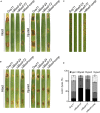Translation Initiation Factor eIF4E Positively Modulates Conidiogenesis, Appressorium Formation, Host Invasion and Stress Homeostasis in the Filamentous Fungi Magnaporthe oryzae
- PMID: 34220879
- PMCID: PMC8244596
- DOI: 10.3389/fpls.2021.646343
Translation Initiation Factor eIF4E Positively Modulates Conidiogenesis, Appressorium Formation, Host Invasion and Stress Homeostasis in the Filamentous Fungi Magnaporthe oryzae
Abstract
Translation initiation factor eIF4E generally mediates the recognition of the 5'cap structure of mRNA during the recruitment of the ribosomes to capped mRNA. Although the eIF4E has been shown to regulate stress response in Schizosaccharomyces pombe positively, there is no direct experimental evidence for the contributions of eIF4E to both physiological and pathogenic development of filamentous fungi. We generated Magnaporthe oryzae eIF4E (MoeIF4E3) gene deletion strains using homologous recombination strategies. Phenotypic and biochemical analyses of MoeIF4E3 defective strains showed that the deletion of MoeIF4E3 triggered a significant reduction in growth and conidiogenesis. We also showed that disruption of MoeIF4E3 partially impaired conidia germination, appressorium integrity and attenuated the pathogenicity of ΔMoeif4e3 strains. In summary, this study provides experimental insights into the contributions of the eIF4E3 to the development of filamentous fungi. Additionally, these observations underscored the need for a comprehensive evaluation of the translational regulatory machinery in phytopathogenic fungi during pathogen-host interaction progression.
Keywords: Magnaporthe oryzae; eIF4E3; fungal pathogenesis; mRNA; translational regulation.
Copyright © 2021 Batool, Shabbir, Lin, Chen, An, He, Pan, Chen, Chen, Wang and Norvienyeku.
Conflict of interest statement
The authors declare that the research was conducted in the absence of any commercial or financial relationships that could be construed as a potential conflict of interest.
Figures








Similar articles
-
Contribution of the Tyrosinase (MoTyr) to Melanin Synthesis, Conidiogenesis, Appressorium Development, and Pathogenicity in Magnaporthe oryzae.J Fungi (Basel). 2023 Feb 28;9(3):311. doi: 10.3390/jof9030311. J Fungi (Basel). 2023. PMID: 36983479 Free PMC article.
-
eIF3k Domain-Containing Protein Regulates Conidiogenesis, Appressorium Turgor, Virulence, Stress Tolerance, and Physiological and Pathogenic Development of Magnaporthe oryzae Oryzae.Front Plant Sci. 2021 Oct 18;12:748120. doi: 10.3389/fpls.2021.748120. eCollection 2021. Front Plant Sci. 2021. PMID: 34733303 Free PMC article.
-
Disruption of putative short-chain acyl-CoA dehydrogenases compromised free radical scavenging, conidiogenesis, and pathogenesis of Magnaporthe oryzae.Fungal Genet Biol. 2019 Jun;127:23-34. doi: 10.1016/j.fgb.2019.02.010. Epub 2019 Feb 27. Fungal Genet Biol. 2019. PMID: 30822500
-
Chrysoviruses in Magnaporthe oryzae.Viruses. 2018 Dec 8;10(12):697. doi: 10.3390/v10120697. Viruses. 2018. PMID: 30544784 Free PMC article. Review.
-
Investigation of the biological roles of autophagy in appressorium morphogenesis in Magnaporthe oryzae.J Zhejiang Univ Sci B. 2008 Oct;9(10):793-6. doi: 10.1631/jzus.B0860013. J Zhejiang Univ Sci B. 2008. PMID: 18837106 Free PMC article. Review.
Cited by
-
Contribution of the Tyrosinase (MoTyr) to Melanin Synthesis, Conidiogenesis, Appressorium Development, and Pathogenicity in Magnaporthe oryzae.J Fungi (Basel). 2023 Feb 28;9(3):311. doi: 10.3390/jof9030311. J Fungi (Basel). 2023. PMID: 36983479 Free PMC article.
-
AGC/AKT Protein Kinase SCH9 Is Critical to Pathogenic Development and Overwintering Survival in Magnaporthe oryzae.J Fungi (Basel). 2022 Jul 31;8(8):810. doi: 10.3390/jof8080810. J Fungi (Basel). 2022. PMID: 36012798 Free PMC article.
-
Characterisation of guided entry of tail-anchored proteins in Magnaporthe oryzae.PLoS Pathog. 2025 Jul 28;21(7):e1013011. doi: 10.1371/journal.ppat.1013011. eCollection 2025 Jul. PLoS Pathog. 2025. PMID: 40720549 Free PMC article.
-
A nonclassically secreted effector of Magnaporthe oryzae targets host nuclei and plays important roles in fungal growth and plant infection.Mol Plant Pathol. 2023 Sep;24(9):1093-1106. doi: 10.1111/mpp.13356. Epub 2023 Jun 12. Mol Plant Pathol. 2023. PMID: 37306516 Free PMC article.
-
Pyricularia oryzae: Lab star and field scourge.Mol Plant Pathol. 2024 Apr;25(4):e13449. doi: 10.1111/mpp.13449. Mol Plant Pathol. 2024. PMID: 38619508 Free PMC article. Review.
References
-
- Aliyu S. R., Lin L., Chen X., Abdul W., Lin Y., Otieno F. J., et al. (2019). Disruption of putative short-chain acyl-CoA dehydrogenases compromised free radical scavenging, conidiogenesis, and pathogenesis of Magnaporthe oryzae. Fungal Genet. Biol. 127 23–34. 10.1016/j.fgb.2019.02.010 - DOI - PubMed
-
- Almeida-Paes R., Figueiredo-Carvalho M. H. G., Brito-Santos F., Almeida-Silva F., Oliveira M. M. E., Zancopé-Oliveira R. M. (2016). Melanins protect Sporothrix brasiliensis and Sporothrix schenckii from the antifungal effects of terbinafine. PLoS One 11:e0152796. 10.1371/journal.pone.0152796 - DOI - PMC - PubMed
LinkOut - more resources
Full Text Sources
Miscellaneous

